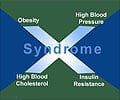New research has indicated that metabolic syndrome biomarkers predict subsequent decline in lung function

"Study participants with dyslipidemia, elevated heart rate or elevated leptin levels had a significantly increased risk of developing abnormal lung function during follow-up," said Anna Nolan, MD, MS, assistant professor of Medicine and Environmental Medicine at NYU Langone Medical Center. "In contrast, elevated amylin levels reduced the risk of developing abnormal FEV1 levels."
The findings were published online ahead of print publication in the American Thoracic Society's American Journal of Respiratory and Critical Care Medicine.
This case-control study was nested within a larger longitudinally followed cohort. All subjects had normal lung function prior to 9/11. Cases (n = 109) were defined as having FEV1 values below the lower limit of normal at follow-up, while controls (n = 218) were defined as having FEV1 at or above the lower limit of normal. Biomarkers were available for 71 cases and 166 controls. Lung function in cases continually declined in the median 28 months between baseline and follow-up examinations, while lung function improved in controls.
In a model adjusting for age, race, body mass index and WTC arrival time, dyslipidemia (triglycerides≥150mg/dL and HDL<40mg/dL) increased the odds of being a case three-fold, elevated heart rate (≥66 bpm) increased the odds more than two-fold, and elevated leptin (≥10,300 pg/mL) increased the odds three-fold. Elevated amylin levels (≥116 pg/mL) decreased the odds of being a case by 84 percent. "This is the first report in humans showing an association between amylin and lung function," Dr. Nolan said. "There are amylin receptors in the lungs, and amylin has been shown to reduce leptin resistance. The protection offered by amylin in this study may have been mediated by these effects."
"These findings suggest that systemic inflammation, a hallmark of the metabolic syndrome, may play a role in promoting lung function impairment in patients with particulate exposure," Dr. Nolan said. "Given the high prevalence of the metabolic syndrome in industrialized nations and the rising incidence in developing nations with high ambient particulate levels, the relationship between these disorders is of considerable importance."
Advertisement
"Our findings in WTC rescue workers highlight the importance of conducting rapid medical monitoring and sample banking following a disaster," said Dr. Nolan. "If we can identify individuals at greater risk of developing lung function impairment, we can initiate appropriate interventions earlier."
Advertisement
Source-Eurekalert














